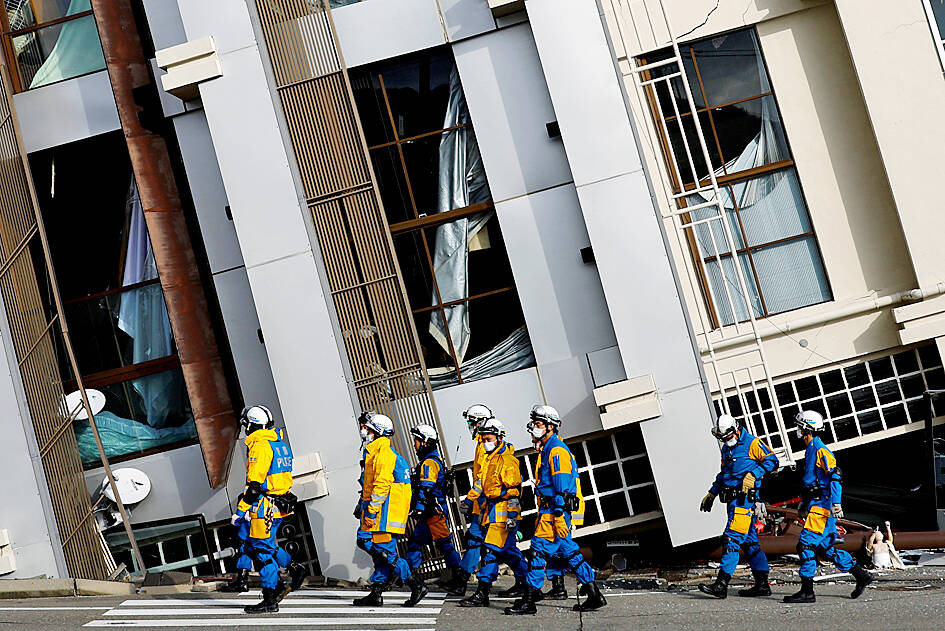Reports that Japan rejected Taiwan’s offer of aid after a magnitude 7.5 earthquake on Monday struck the Noto region of Ishikawa Prefecture are untrue, the Ministry of Foreign Affairs said yesterday.
The National Fire Agency on Monday night completed mobilization of 160 search-and-rescue personnel to depart for Japan if required.
The ministry notified Japan of its preparedness and expressed its willingness to help.

Photo: Reuters
However, Tokyo had deployed thousands of Japan Self-Defense Forces personnel and would consider accepting foreign assistance depending on the situation, the ministry said.
Online rumors saying that Japan “rejected” Taiwan’s help were inappropriate and “inconsistent” with the actual communication between the two governments, it said.
Taiwan “fully understands and respects” the plans of the Japanese government and maintains close contact with Japan to provide any assistance as needed, it said.
Japanese Prime Minister Fumio Kishida on Thursday told a news conference that dozens of countries and regions around the globe — including Taiwan, the US, other NATO countries and China — had expressed their condolences and offered to assist after the earthquake.
While feeling deeply grateful for the offers, Japan was not planning to accept any human or material support from other countries for the time being, but only support that would not affect its rescue system on site, Kishida said, citing Taiwan’s donation of ¥60 million (US$413,009) as an example.
Japanese Chief Cabinet Secretary Yoshimasa Hayashi yesterday told a news conference that Japan would cooperate closely with US troops in Japan according to the damage and needs of earthquake-stricken areas.
US Department of Defense spokesman Brigadier General Patrick Ryder on Thursday said that “our military forces in Japan are ready to assist as needed,” adding that the forces were “in regular contact with the government of Japan to discuss how we might help.”
The Japan Self-Defense Forces were fully engaged in immediate rescue missions on site, so it would be difficult for them to quickly establish a collaborative structure alongside foreign support, the Nikkei Shimbun reported yesterday.
The US military launched its Operation Tomodachi in the aftermath of the 2011 Tohoku earthquake and tsunami, and set up a joint coordination center with Japan to cooperate on transporting supplies and other missions after the Kumamoto earthquake in 2016, the newspaper said.
The Self-Defense Forces had mobilized 10,000 troops by Tuesday to help with the rescue efforts and had dispatched about 5,000 troops to the affected areas by Thursday, the paper said.
As of yesterday, about 33,000 people had been evacuated to about 370 evacuation centers in Ishikawa Prefecture, it said, adding that about 27,000 homes were without electricity due to the quake, while about 68,000 houses in 14 cities and towns had no water supply.

‘CHARM OFFENSIVE’: Beijing has been sending senior Chinese officials to Okinawa as part of efforts to influence public opinion against the US, the ‘Telegraph’ reported Beijing is believed to be sowing divisions in Japan’s Okinawa Prefecture to better facilitate an invasion of Taiwan, British newspaper the Telegraph reported on Saturday. Less than 750km from Taiwan, Okinawa hosts nearly 30,000 US troops who would likely “play a pivotal role should Beijing order the invasion of Taiwan,” it wrote. To prevent US intervention in an invasion, China is carrying out a “silent invasion” of Okinawa by stoking the flames of discontent among locals toward the US presence in the prefecture, it said. Beijing is also allegedly funding separatists in the region, including Chosuke Yara, the head of the Ryukyu Independence

UNITED: The premier said Trump’s tariff comments provided a great opportunity for the private and public sectors to come together to maintain the nation’s chip advantage The government is considering ways to assist the nation’s semiconductor industry or hosting collaborative projects with the private sector after US President Donald Trump threatened to impose a 100 percent tariff on chips exported to the US, Premier Cho Jung-tai (卓榮泰) said yesterday. Trump on Monday told Republican members of the US Congress about plans to impose sweeping tariffs on semiconductors, steel, aluminum, copper and pharmaceuticals “in the very near future.” “It’s time for the United States to return to the system that made us richer and more powerful than ever before,” Trump said at the Republican Issues Conference in Miami, Florida. “They

GOLDEN OPPORTUNITY: Taiwan must capitalize on the shock waves DeepSeek has sent through US markets to show it is a tech partner of Washington, a researcher said China’s reported breakthrough in artificial intelligence (AI) would prompt the US to seek a stronger alliance with Taiwan and Japan to secure its technological superiority, a Taiwanese researcher said yesterday. The launch of low-cost AI model DeepSeek (深度求索) on Monday sent US tech stocks tumbling, with chipmaker Nvidia Corp losing 16 percent of its value and the NASDAQ falling 612.46 points, or 3.07 percent, to close at 19,341.84 points. On the same day, the Philadelphia Stock Exchange Semiconductor Sector index dropped 488.7 points, or 9.15 percent, to close at 4,853.24 points. The launch of the Chinese chatbot proves that a competitor can

‘VERY SHALLOW’: The center of Saturday’s quake in Tainan’s Dongshan District hit at a depth of 7.7km, while yesterday’s in Nansai was at a depth of 8.1km, the CWA said Two magnitude 5.7 earthquakes that struck on Saturday night and yesterday morning were aftershocks triggered by a magnitude 6.4 quake on Tuesday last week, a seismologist said, adding that the epicenters of the aftershocks are moving westward. Saturday and yesterday’s earthquakes occurred as people were preparing for the Lunar New Year holiday this week. As of 10am yesterday, the Central Weather Administration (CWA) recorded 110 aftershocks from last week’s main earthquake, including six magnitude 5 to 6 quakes and 32 magnitude 4 to 5 tremors. Seventy-one of the earthquakes were smaller than magnitude 4. Thirty-one of the aftershocks were felt nationwide, while 79